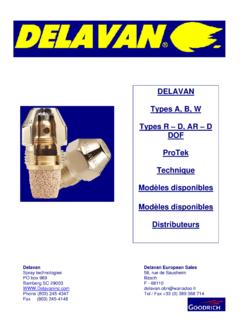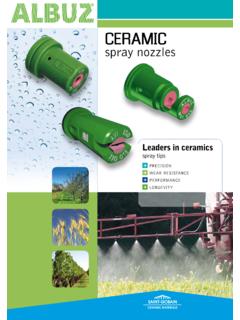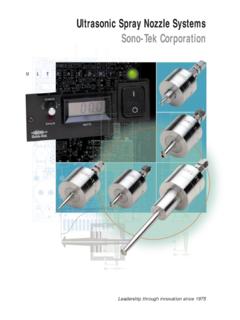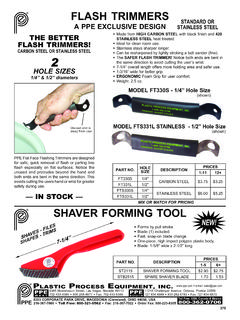Transcription of How to select the right nozzle - Delavan Inc
1 Figure 1. Definitely hollow air pattern for one type of pattern is from a Shell Head 1A. A modified hollow air to select the right nozzleA number of things must be considered to matchspray pattern to air pattern for quiet, efficient performanceBy Eugene O. OlsonDivision Engineering ManagerDelavan Manufacturing CompanyWest Des Moines, IowaMatching of the atomizing nozzle spraypattern to the air pattern from an oilburner sounds like a very simple cut anddried procedure. You hear it said that ahollow air pattern must have a hollowspray pattern and that a solid air patternmust have a solid nozzle spray rule may be completely valid,but the fact is that no burnermanufacturer does it exactly that experience in servicing burners alsodictates variations from that ruledepending upon many things such as thespray angle, the combustion chamber sizeand shape, furnace or boiler configurationand the noise or pulsation tendency of we get into a discussion ofthe subject, it might be well to define ourterms so that we can be talking the air pattern of a burner is simplya picture of the air velocities (feet permin.)
2 At various points. This tells uswhere the air is available for the air patterns shown here are fromactual production example, in Figure 1, it is plainthat more air is available at the outeredges of the air pattern than in the would define this as a hollow air pattern from another burneris shown in Figure 1A. This pattern is notas open as the first one, but is still quitedefinitely a hollow type the first of these patterns,recirculating gases in the center of thepattern are traveling toward the burnerrather than away from it. There is alsosome recirculation at the outer edges ofthe pattern and all of this helps tomaintain a stable flame front and pattern shown in Figure 2 isentirely different in that the air velocity inthe center is higher than in other parts ofthe pattern.
3 This is generallycharacterized as a solid air pattern. Thereare variations of this pattern fromdifferent burners of the conventional typedepending upon the combination of staticdiscs and end cones used. Some havehigher air velocities in the center. Othershave lower center common featuresFigure 3 shows a pattern from atypical flame retention burner. Theseburners do not all have the same patternbut on the basis of the few burners wehave checked they seem to have twofeatures in There are two air patterns, a highvelocity, solid stream in the center and alighter hollow pattern at the Between those two patterns is anannulus of recirculation extending backto the retainer disc. This is apparentlywhat holds the flame at the any burner regardless of its airpattern the atomizing nozzle must assistthe burner to do certain things:1.
4 Thespray must The nozzle must provide a spraythat will maintain a steady, quiet fire inthe particular air The nozzle must provide a patternand droplet size that will burn clean withno The combination of the air patternand fuel pattern must provide accomplish these things, nozzlesare available in different spray patternsand different spray angles. Defining aspray pattern requires that we establish atest procedure. Several different methodsare used in the industry, somequantitative and some qualitative. All ofthese do not produce the same results orinterpretation of a spray pattern. Forpurposes of this discussion, I shallillustrate only one 4 shows the arrangement ofthe sampling equipment and a hollowpattern. This particular pattern shows thatthe highest concentration of droplets inthe spray is near the outside edge of 2.
5 Typicalair pattern for aconvention burnerwith a static discand cast-iron 3. Patternproduced by aflame 4. Typicalhollow cone 5. Typicalsolid cone 5 shows a common solid conetype of spray showing a slight depressionin the center of the pattern, but actuallywith fairly uniform distribution across thecross section of the sprayThe classical illustration of hollowcone and solid cone sprays as shown inFigure 6 is strictly schematic. Nobodybuilds nozzles with that kind of spraypattern. As a matter of fact, it isimpossible. The sketches of the crosssections of hollow cone and solid conesprays in Figure 7 are intended toillustrate the fact that all sprays leave theorifice in a hollow conical film of liquidand further along, liquid a hollow cone spray some dropletsare thrown outward on the outside ofwhat could be called the "effective sprayangle.
6 " At the same time, droplets arealso thrown on the inside of the mainconcentration of droplets, thus giving agreater thickness to the wall of the spraycone than we usually illustrate. This isapparent by the amounts of liquid shownin the tubes for a hollow cone patternTo make a solid cone nozzle , wesimply increase the turbulence of thehollow conical film of liquid leaving theorifice of the nozzle . This throws moredroplets outside and especially, inside ofthe principal cone. It is possible tocontrol the amount of liquid, which isdelivered inside of the effective sprayangle by nozzle design to obtain differentspray characteristics. Thus, a so-calledsolid cone spray might be heavy in theFigure 6. The usual illustration ofhollow and solid sprays; 7. Schematic illustrations ofdroplet distribution in hollow and solidcone sprays, or it might lean toward the hollowtype with simply a thicker wall in thespray cone, depending upon flow rate is increased, thehollow cone spray becomes morestreamlined and hollow.
7 Likewise, asflow rate increases, the solid conebecomes less solid. For example, at 20gph it is very difficult to make a truesolid cone nozzle without increasing thedroplet size and velocity above whatcould be tolerated in an oil are differences in thedefinitions of hollow cone and solid conesprays between the various nozzlemanufacturers. This usually comes aboutbecause of the different test methods usedand is influenced also by theinterpretation of what the industry canuse in the average burner of either nozzle manufacturer knows that theserviceman is not a research typeindividual with laboratory facilities and,therefore, endeavors to supply him anozzle that will fire the average I am saying is that the hollowcone nozzle must be hollow enough tofire the very hollow cone burners and atthe same time work well in those not sohollow.
8 The solid cone nozzle must besolid enough to give the desiredperformance in a burner requiring a solidcone nozzle ,At the same time it must not producethe objectionable performancecharacteristics that may be encounteredwith a heavy center spray. The so-calledall purpose patterns are simplycompromises to work in the averageburner. They are designed to work well inmost burners and thus simplify the stockproblems and burner analysis problemsfor patternsWe now face the problem of puttingthe correct nozzle spray pattern into theburner air pattern for best majority of installed burners in thefield are of the conventional type using astatic disc or turbulator and an end conewith or without vanes, producing an airpattern somewhat similar to Figure you are trying to achievemaximum efficiency, you could reasonthat this air pattern should have a solidcone nozzle probably 45 or 60.
9 Ifefficiency were the only criterion, thisconclusion would probably be true. Wemust not forget, however, that many ofthese units are fired into round or squarecombustion chambers and they areinstalled in burners or boilers that undercertain conditions can pulsate or is, therefore, common practice formanufacturers of these burners to specifyhollow cone nozzles in the small sizes,that is, up to approximately gph at the illustrations it wouldalso seem out of place to use 80 or 90 hollow cone nozzles in this air is being done, however, and it is notuncommon to attain CO2 readings as highas 12% in certain installations with 70 or80 .The reason this sort of matching canbe done is that with the extremely smalldroplet sizes in the low flow rates, the airflow moves these droplets rather easilyand it is possible, therefore, to attain thisgood efficiency.
10 A hollow cone spraygives a short bushy fire. A true solid conenozzle may give a longer fire that wouldimpinge on the target wall of a square orround principal reason that the hollowcone is used in these patterns is the noisefactor. It has been demonstrated inpractice and documented by researchlaboratories that pulsation usuallyemanates from the center of the spraymixture. If there is a concentration ofdroplets in the center of the fire withinsufficient air to burn them, we have a rich mixture in the center ofthe fire, it has been found that periodicignition occurs and these periodic flamesalternate with areas of no flame. This hasbeen illustrated by high-speed extensive research projectestablished a definite correlation betweenthe amplitude of pulsation and the degreeof "solidness" of the nozzle spray.








